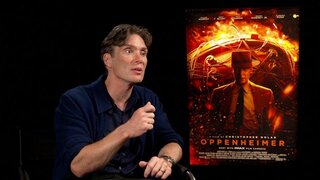10 Years Later, This Sci-Fi Epic Is Still Christopher Nolan's Most Emotional Film Ever
Let's revisit the deeply emotional Christopher Nolan sci-fi film for its 10th anniversary.
Interstellar was, like so many Christopher Nolan films, promoted on the basis of spectacle. It was meant to be Nolan's 2001: A Space Odyssey, the clearest possible reflection of Stanley Kubrick's methodical tendencies in his own filmmaking style, a film packed with lavish, awe-inspiring visuals and big ideas.
Real-life physicists were brought in to consult on Interstellar (now streaming on Peacock), to unpack its scientific concepts, to make sure everything retained a sense of plausibility. This was a film about conceptual breadth and depth, and its entire marketing push reflected that as it rolled into theaters 10 years ago this month. But that was never the whole story.
When Christopher Nolan gets dinged for shortcomings as a filmmaker, what very often comes up is the sense of detachment some viewers find running through his films, the feeling that, while not emotionless, Nolan is less interested in the humanity of his stories than he is in the narrative possibilities. Nolan's own interests –– big thinkers with big ideas, large-format cinematography, narrative formalism –– seem to back this up, even as those of us who love his films still find the emotional resonance inside those preoccupations. Interstellar seemed like the perfect place for Nolan to flex his conceptual muscles while leaving emotion behind, but he didn't do that. Instead, he told the most emotional story of his career so far, a family saga nestled inside a sci-fi epic. And a decade later, it still packs just as much of a punch.
Why Interstellar is still so powerful
The basic framework of Interstellar is an epic, visually stunning space voyage: Cooper (Matthew McConaughey), a farmer and father who used to pilot ships for NASA, is called back to the space agency for a mission that might save humanity. Leaving his family behind, Cooper and a small crew fly vast distances through space, seeking out various worlds that have been labeled potential candidate worlds to play home to humanity as the Earth dies. Meanwhile back home, Cooper's daughter, Murph (Jessica Chastain), grows to adulthood and works with NASA to solve the complex math that would allow humans to travel vast interstellar distances to get to those habitable worlds.
It's a very straightforward space mission movie, and it unfolds with typical Nolan splendor, from a world comprised entirely of an ocean spewing out massive waves to an ice world where a mad astronaut (Matt Damon) lies in wait. Much has already been written about the power of these sequences, the visual awe they inspire, and indeed Interstellar remains one of Nolan's most satisfying cinematic experiences, particularly if you were among the people who got to see it in IMAX back in 2014.
But that's not what makes Interstellar an emotional dynamo among Nolan's filmography. For that, we have to turn to a closer look at the film's ending, and the way Nolan chose to resolve his story.
We learn midway through the film that the much-vaunted formula NASA hopes to use to send humanity away from Earth and to another world is incomplete, and that it can only be completed via data obtained by going directly inside a black hole, which is data that no one has. At the end of the film, Cooper himself falls into a black hole as part of a sacrifice play to get his one remaining crew member, Amelia (Anne Hathaway), to the final potential world. What he finds inside, other than the nothingness you might expect, is a strange tesseract space which, when studied, is revealed to be the bookshelves in the home he once shared with his daughter.
Through a classic time travel paradox, it seems that future humans, who survived after all, built this tesseract and placed it in the black hole so that Cooper could communicate with Murph, using the books and an old family wristwatch to tap out the data she needs to complete the formula and save humanity. It's a deeply emotional moment, because on top of its relevance to the plot, it's a father desperately trying to communicate with his daughter, a daughter who's aged decades while he couldn't be there for her.
That alone is enough to make Interstellar an emotional punch, and the sequence still holds up on the pure strength of its performances. But what really puts the film over the top among Nolan's other films is, believe it or not, the narrative tricks that got us to that point. The time travel paradox at the heart of the film's climax tells us that in the future, advanced humans built this tesseract and sent it into the black hole. It was a deliberate positioning of a structure that would allow Cooper to transmit his data, but that also means it could have been anything. It could have been a computer panel, or a chalkboard. If they're advanced enough to build a space inside a black hole, future humans could have come up with all manner of literal plot devices to move the story forward.
But instead of any of those other things, they took both Cooper and Murph back home, to a key moment, a key place, a key series of family relics that held resonance for both of them. They understood that it wasn't just knowledge being transmitted across space and time, but emotion, love, a sense of enduring. They understood that Cooper and Murph needed that moment to reconnect in a place they'd never share again, because sometimes that's all any of us need.
That's what makes Interstellar one of the most emotionally satisfying genre films of the last decade, and the most emotionally resonant film Christopher Nolan has produced so far.
Interstellar is now streaming on Peacock.
















































